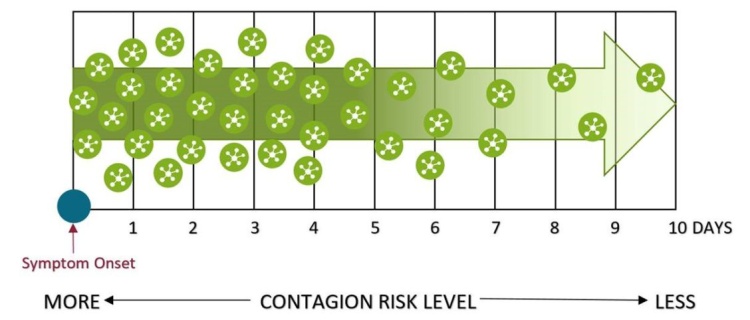How long are you contagious when you have COVID-19?
Archived Blog Post
This blog post is archived and might not be accurate anymore.
If you recently tested positive for COVID-19, you might be wondering how long you’re able to get others sick. You are most infectious (or contagious) in the first 5 days after your symptoms start. You can also spread COVID-19 in the 48 hours before your symptoms start. If you never have symptoms, consider yourself most infectious in the 5 days after you test positive.
Because you can still be infectious, wear a mask after your 5-day isolation ends.
Infectiousness usually begins to decrease after day 5, but this doesn’t mean you can’t spread the virus beginning on day 6. This is why it is SO important to wear a mask through day 10. Everyone’s immune response is different, and we can spread the virus for different amounts of time. Masking on days 6-10 helps reduce the risk that we will get others sick after recovering from COVID-19. Most people are no longer infectious after day 10.

Graphic adapted from GoodRxHealth.
A few special considerations for isolation
- If you become severely sick with COVID-19, you may be contagious for longer than those who are mildly ill. If you were very sick from COVID, isolate for at least 10 full days after your symptoms start. You could need to isolate longer depending on your individual situation; if you become severely sick or are immunocompromised, talk to your doctor before ending isolation.
- If you test positive but don’t have symptoms, then later you do have symptoms within 10 days of testing, you should restart your isolation period with day 0 being the day your symptoms started.
Antiviral medicine can help keep you from getting really sick with COVID.
Antiviral treatments can protect you from becoming seriously ill from COVID-19 or needing hospitalization. However, in order to be eligible you must be able to begin antiviral medicine within 5 days of when your symptoms start. Starting antiviral medicine after this window may not be as effective.
You can get antiviral medication free, even if you don’t have insurance. See the state health department’s webpage on COVID-19 Treatment & Telehealth Appointments for more information.
You do not need a negative test to be released from isolation.
You do not have to take a test and be negative to leave isolation on day 6. You can leave isolation if:
- It has been 5 days after your symptoms began (or if you never develop symptoms, 5 days after your initial positive test), and
- You are fever-free for at least 24 hours (without taking fever-reducing medications), and
- Other symptoms are improving
You can return to work, school, etc. but on days 6-10, you must wear a well-fitting, high quality mask around others (you may be able to use home tests to stop wearing your mask before day 10; read more about this method).
Why shouldn’t I test again?
We do not recommend that people who were mildly ill with COVID-19 wait to take a test to leave isolation. Both PCR tests and antigen tests (including home tests) can continue to turn up positive even after someone is no longer considered infectious. Read more about the duration of testing positive on the CDC’s website.
This content is free for use with credit to Public Health Madison & Dane County .


